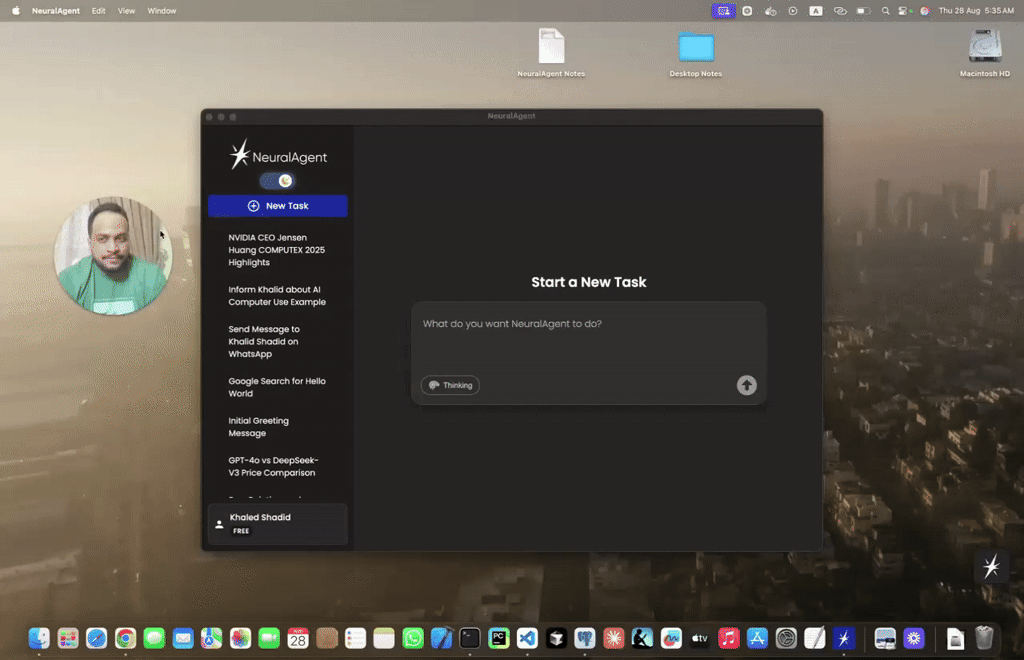Table of Contents
Overview
Envision an AI assistant that operates directly on your desktop, automating tasks through intelligent interaction with your applications and operating system. NeuralAgent is an innovative desktop automation platform designed to perform complex tasks by simulating human computer interactions including clicking, typing, scrolling, and navigation. This open-source solution enables users to delegate repetitive tasks and enhance desktop productivity through natural language commands, representing a significant advancement in local AI-powered automation technology.
Key Features
NeuralAgent incorporates several sophisticated capabilities designed to provide comprehensive desktop automation while maintaining user privacy and system security.
- Natural Language Command Processing: Communicate with NeuralAgent using conversational English, making advanced automation accessible to users without technical programming backgrounds.
- Contextual Intelligence and Adaptive Learning: The AI system understands task context and learns from user interactions, continuously improving its performance and accuracy over time.
- Direct System Control: NeuralAgent operates through mouse and keyboard simulation, enabling interaction with virtually any desktop application regardless of API availability.
- Cross-Platform Compatibility: Functions seamlessly across Windows, macOS, and Linux operating systems, providing broad accessibility for diverse computing environments.
- Local Processing Architecture: All computation occurs on the user’s device, ensuring data privacy and eliminating dependencies on cloud-based services.
- Background Task Execution: Capable of performing automated tasks in background mode, allowing users to maintain productivity while automation occurs independently.
How It Works
NeuralAgent operates through a streamlined workflow designed for intuitive user interaction and reliable task execution. Users initiate automation by entering natural language prompts through the application’s command interface, describing the desired task or workflow. The AI system processes and interprets these commands, breaking down complex requests into actionable steps while considering current system context. Through direct system interaction, NeuralAgent executes the required actions using simulated mouse movements, keyboard inputs, and application navigation. All processing occurs locally on the user’s machine, ensuring data security while providing responsive performance without internet connectivity requirements.
Use Cases
NeuralAgent addresses various automation scenarios where desktop task delegation provides significant productivity benefits for individual users and organizations.
- Administrative Task Automation: Streamline form completion, email composition, and data entry tasks across multiple applications, reducing manual effort and minimizing human error.
- Web-Based Data Collection: Automate website navigation, information extraction, and data compilation processes for research, competitive analysis, and content gathering.
- Cross-Application Workflow Integration: Create seamless data transfer and task execution chains between different software applications, eliminating manual switching and copy-paste operations.
- Document and Report Generation: Delegate time-intensive tasks such as data compilation, formatting, and report creation, enabling focus on higher-value analytical work.
Pros \& Cons
Advantages
- Enhanced Privacy Through Local Processing: All data remains on the user’s device, providing comprehensive privacy protection and eliminating cloud-based data exposure risks.
- Universal Application Compatibility: Functions across all major operating systems and can interact with any graphical user interface, regardless of application architecture or API availability.
- Sophisticated Task Automation: Capable of handling complex, multi-step processes that typically require extensive human interaction and decision-making.
- Open-Source Flexibility: MIT license enables customization, community contributions, and integration with existing systems without vendor lock-in concerns.
Disadvantages
- Hardware Performance Dependencies: Requires adequate system resources including CPU, GPU, and memory for optimal performance, potentially limiting use on older or resource-constrained devices.
- Platform-Specific Operational Constraints: While cross-platform compatible, certain advanced features or optimizations may vary between different operating systems.
- System-Level Access Considerations: Direct system control capabilities require careful implementation and user awareness to ensure intended operation and maintain system security.
How Does It Compare?
In the evolving landscape of desktop automation and AI-powered productivity tools, NeuralAgent positions itself uniquely within several distinct market segments. Claude Computer Use represents Anthropic’s approach to AI-driven computer interaction, offering both cloud and local deployment options with enterprise-focused API integration, targeting organizations requiring sophisticated AI capabilities with professional support structures. Rabbit R1 operates as a dedicated hardware device priced at \$199, implementing Large Action Model technology to serve as a smartphone alternative, focusing on consumer portability rather than desktop automation.
Enterprise RPA solutions like UiPath and Microsoft Power Automate provide comprehensive business process automation with extensive enterprise features, robust governance controls, and professional services support, serving organizations requiring large-scale automation deployments with regulatory compliance capabilities. Traditional API integration platforms such as Zapier focus on connecting web services and applications through predefined workflows, offering broad service compatibility but limited desktop-level interaction capabilities.
NeuralAgent differentiates itself through its combination of open-source accessibility, local processing architecture, and direct GUI interaction capabilities. While enterprise solutions provide broader feature sets and professional support, NeuralAgent offers cost-effective automation for individual users and small organizations. Unlike hardware-based solutions, it leverages existing computing infrastructure while maintaining privacy through local processing. The optimal choice depends on specific automation requirements, technical expertise, privacy considerations, and organizational scale.
Final Thoughts
NeuralAgent represents a notable advancement in desktop automation technology, addressing the growing need for accessible, privacy-conscious AI-powered productivity tools. Its emphasis on local processing, open-source development, and natural language interaction provides significant value for users seeking to automate complex desktop workflows without cloud dependencies or expensive enterprise licensing. While operating in a competitive market with established players offering alternative approaches, NeuralAgent’s unique combination of accessibility, privacy, and technical capability positions it as a valuable solution for the emerging market of AI-native desktop automation. The platform’s continued development will likely benefit from its open-source community and focus on user privacy as automation becomes increasingly central to personal and professional computing workflows.
